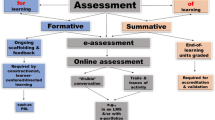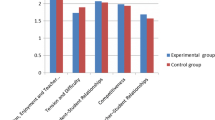Abstract
This research investigated 68 secondary school students’ perceptions of their computer-mediated project-based learning environment and their attitudes towards Project Work (PW) using two instruments—Project Work Classroom Learning Environment Questionnaire (PWCLEQ) and Project Work Related Attitudes Instrument (PWRAI). In this project-based learning environment, students experienced a face-to-face classroom setting and e-learning by using a synchronous computer-mediated communication (CMC) tool called ‘iCollaborate’ for online communication and project collaboration with peers from other countries. The PWCLEQ and PWRAI instruments were used to evaluate the computer-mediated project-based learning environment using students’ perceptions of the learning environment and to further investigate how their perceptions might affect their attitudes towards PW lessons. Students perceived the computer-mediated project-based learning environment favourably but they preferred to experience more Material Environment and more Open-Endedness and Social Presence. Simple correlation analysis revealed that all environment dimensions were significantly and positively related to the students’ attitudes towards PW, while multiple regression analysis indicated that two scales, Instructor Support and Social Presence, were the strongest predictors of attitudes towards PW lessons.
Similar content being viewed by others
References
Asghar, M., & Fraser, B. (1995). Classroom environment and attitudes to science in Brunei Darussalam. Journal of Science and Mathematics Education in Southeast Asia, 18(2), 41–47.
Bransford, J. D., Brown, A. L., & Cocking, R. R. (Eds.). (2000). How people learn: Brain, mind, experience, and school. Washington, DC: National Academy Press.
Chang, V., & Fisher, D. (2003). The validation and application of a new learning environment instrument to evaluate online learning in higher education. In M. S. Khine & D. Fisher (Eds.), Technology-rich learning environments: A future perspective (pp. 1–18). Singapore: World Scientific.
Chionh, Y. H., & Fraser, B. J. (2009). Classroom environment, achievement, attitudes and self esteem in geography and mathematics in Singapore. International Research in Geographical and Environmental Education, 18, 29–44.
Deemer, S. A. (2004). Classroom goal orientation in high school classrooms: Revealing links between teacher beliefs and classroom environments. Educational Research, 46(1), 73–90.
Derntl, M., & Motschnig-Pitrik, R. (2005). The role of structure, patterns and people in blended learning. The Internet and Higher Education, 8(2), 111–130.
Dorman, J. P. (2001). Associations between classroom environment and academic efficacy. Learning Environments Research, 4, 243–257.
Dorman, J. P., Adams, J. E., & Ferguson, J. M. (2003). A cross-national investigation of students’ perceptions of mathematics classroom environment and academic efficacy in secondary schools. International Journal for Mathematics Teaching and Learning. Retrieved November 1, 2009, from http://www.cimt.plymouth.ac.uk/journal/dormanj.pdf.
Dziuban, C. D., Hartman, J. L., & Moskal, P. D. (2004). Blended Learning. EDUCAUSE Research Bulletin, 2004(7). Retrieved October 18, 2009, from http://net.educause.edu/ir/library/pdf/ERB0407.pdf.
Dziuban, C. D., Moskal, P. D., & Hartman, J. (2005). Higher education, blended learning, and the generations: Knowledge is power: No more. In J. Bourne & J. C. Moore (Eds.), Elements of quality online education: Engaging communities (pp. 85–100). Needham, MA: Sloan Center for Online Education.
Fraser, B. J. (1981). Test of Science-Related Attitudes. Melbourne, Australia: Australian Council for Educational Research.
Fraser, B. J., & Lee, S. S. U. (2009). Science laboratory classroom environments in Korean high schools. Learning Environments Research, 12, 67–84.
Gaver, W. W. (1991). Technology affordances. In S. P. Robertson, G. M. Olson, & J. S. Olson (Eds.), Proceedings of the SIGCHI Conference on Human factors in computing systems: Reaching through technology (pp. 79–84). New Orleans, LA: ACM.
Goh, S. C., & Fraser, B. J. (1998). Teacher interpersonal behaviour, classroom environment and student outcomes in primary mathematics in Singapore. Learning Environments Research, 1, 199–229.
Hopson, M. H., Simms, R. L., & Knezek, G. A. (2001). Using a technology-enriched environment to improve higher-order thinking skills. Journal of Research on Technology in Education, 34(2), 109–119.
Jamaludin, A., & Quek, C. L. (2006). Using asynchronous online discussions in primary school project work. Australasian Journal of Educational Technology, 22, 64–87.
Jonassen, D. (1991). Objectivism versus constructivism: Do we need a new philosophical paradigm? Educational Technology Research and Development, 39, 5–14.
Jonassen, D. H. (2000). Computers as mindtools for schools: Engaging critical thinking. Upper Saddle River, NJ: Merrill/Prentice Hall.
Khine, M. S., & Goh, S. C. (2001, December). Investigation of tertiary classroom learning environment in Singapore. Paper presented at the annual conference of the Australian Association for Research in Education, Fremantle, Australia.
Kim, H., Fisher, D. L., & Fraser, B. J. (1999). Assessment and investigation of constructivist science learning environments in Korea. Research in Science and Technological Education, 17, 239–249.
Kirschner, P., Strijbos, J. W., Kreijns, K., & Beers, P. J. (2004). Designing electronic collaborative learning environments. Educational Technology Research and Development, 52(3), 47–66.
Kohlberg, L., & Mayer, R. (1972). Development as the aim of education. Harvard Educational Review, 42, 449–496.
Koistinen, K. (2002, April). Towards virtual academy—Teacher’s changing role. Paper presented at the FIG Congress 2002, Washington, DC.
Kwok, L. Y., & Tan, Y. G. (2004, May–June). Scaffolding supports in project-based learning through Knowledge Community: Collaborative learning strategies and pedagogical facilitation. Paper presented at the 8th Global Chinese Conference on Computers in Education (GCCCE2004), Hong Kong.
Lee, S. S. U., & Fraser, B. J. (2000, June–July). The constructivist learning environment of science classrooms in Korea. Paper presented at the annual meeting of the Australasian Science Education Research Association, Fremantle, Australia.
Lewin, K. (1936). Principles of topological psychology. New York: McGraw-Hill.
Lim, C. P., & Tay, L. Y. (2004). Engagement in higher order thinking mediated by ICT tools. In C. P. Lim (Ed.), Integrating ICT in education (pp. 102–126). Singapore: McGraw Hill Education.
Majeed, A., Fraser, B. J., & Aldridge, J. M. (2002). Learning environment and its associations with student satisfaction among mathematics students in Brunei Darussalam. Learning Environments Research, 5, 203–226.
Marzano, R. J., Brandt, R. S., Hughes, C. S., Jones, B. F., Presseisen, B. Z., Rankin, S. C., et al. (1988). Dimensions of thinking: A framework for curriculum and instruction. Alexandria, VA: Association for Supervision and Curriculum Development.
Marzano, R. J., Pickering, D., & McTighe, J. (1993). Assessing student outcomes: Performance assessment using the dimensions of learning model. Alexandria, VA: Association for Supervision and Curriculum Development.
Merrill, D. (1991). Constructivism and instructional design. Educational Technology, 31(5), 45–53.
Moos, R. H. (1974). The social climate scales: An overview. Palo Alto, CA: Consulting Psychologists Press.
Picciano, A. G. (2006). Blended Learning: Implications for growth and access. Journal of Asynchronous Learning Networks, 10(3), 95–102.
Postholm, M. B., Pettersson, T., Flem, A., & Gudmundsdottir, S. (2002, June). The teacher’s role when pupils use ICT during project work. Paper presented at the ISCAR Conference, Amsterdam.
Quek, C. L. (2009). Designing a computer-supported project-based learning environment for high school students: A case study. Journal for Computing Teachers, Spring 2009. Retrieved October 7, 2009, from http://www.iste.org/Content/NavigationMenu/Membership/SIGs/SIGCS_Computer_Science_/JCTJournalforComputingTeachers/PastIssues/2009/Spring/lang_designing.pdf.
Quek, C. L., Divaharan, S., Liu, W. C., Peer, J., Williams, M. D., Wong, A. F. L., et al. (Eds.). (2005a). Engaging in project work. Singapore: McGraw-Hill Education (Asia).
Quek, C. L., Peer, J., Divaharan, S., Williams, M. D., Wong, A. F. L., & Jamaludin, A. (2005b). Computer mediated communication as a collaborative tool for facilitating student-centered learning in project-based classrooms. Educational Technology, 45(4), 48–51.
Quek, C. L., & Wong, A. F. L. (2002). Is my project work classroom environment conducive for student collaboration? Teaching and Learning, 23(2), 107–118.
Quek, C.-L., Wong, A. F. L., Divaharan, S., Liu, W.-C., Peer, J., & Williams, M. D. (2007). Secondary school students’ perceptions of teacher–student interaction and students’ attitudes towards project work. Learning Environments Research, 10(3), 177–187.
Quek, R., Hui, T., & Masuath, M. (2005c, November–December). Use of scaffolds in an ICT project work. Paper presented at the Educational Research Association Conference, Singapore.
So, H.-J. (2009). When groups decide to use asynchronous online discussions: Collaborative learning and social presence under a voluntary participation structure. Journal of Computer Assisted Learning, 25, 143–160.
Swan, K., Shea, P., Fredericksen, E., Pickett, A., Pelz, W., & Maher, G. (2000). Building knowledge building communities: Consistency, contact and communication in the virtual classroom. Journal of Educational Computing Research, 23, 359–383.
Tam, M. (2009). Constructivism, instructional design and technology. In J. Willis (Ed.), Constructivist instructional design: Foundations, models and examples (pp. 61–80). Charlotte, NC: Information Age Publishing.
Tan, C., & Kwok, P. (2005, November–December). Knowledge building in inter-school learning communities: Reflections from a case on project learning in Hong Kong. Paper presented at the International Conference in Computers in Education 2005, Singapore.
Vygotsky, L. S. (1978). Mind in society: The development of higher psychological processes. Cambridge, MA: Harvard University Press. (Original work published 1930, 1933 and 1935).
Walberg, H. J., & Anderson, G. J. (1968). Classroom climate and individual learning. Journal of Educational Psychology, 59, 414–419.
Wang, Q. (2009). Designing a web-based constructivist learning environment. Interactive Learning Environments, 17(1), 1–13.
Wertsch, J. V. (1984). The zone of proximal development: Some conceptual issues. In B. Rogoff & J. V. Wertsch (Eds.), Children’s learning in the “zone of proximal development” (pp. 7–18). San Francisco: Jossey-Bass.
Wong, A. F. L., & Fraser, B. J. (1996). Environment-attitude associations in the chemistry laboratory classroom. Research in Science and Technological Education, 14, 91–102.
Yeo, T. M., & Quek, C. L. (2008). Investigating design and technology students’ participation and learning in a technology mediated learning environment. Australasian Journal of Educational Technology, 24, 540–555.
Young, T. (1998). Student Teachers’ Attitudes Towards Science (STATS). Evaluation and Research in Education, 12(2), 96–111.
Author information
Authors and Affiliations
Corresponding author
Rights and permissions
About this article
Cite this article
Seet, L.Y.B., Quek, C.L. Evaluating students’ perceptions and attitudes toward computer-mediated project-based learning environment: A case study. Learning Environ Res 13, 173–185 (2010). https://doi.org/10.1007/s10984-010-9073-8
Received:
Accepted:
Published:
Issue Date:
DOI: https://doi.org/10.1007/s10984-010-9073-8




